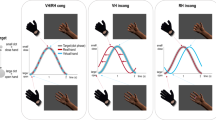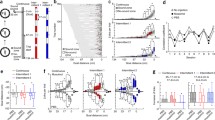Abstract
We extend an Active Inference theory in continuous time of how neural circuitry in the Dorsal Visual Stream (DVS) and the Posterior Parietal Cortex (PPC) implement visually guided goal-directed behavior with novel capacity to resolve multi-step tasks. According to the theory, the PPC maintains a high-level internal representation of the causes of the environment (belief), including bodily states and objects in the scene, and by generating sensory predictions and comparing them with observations it is able to learn and infer the causal relationships and latent states of the external world. We propose that multi-task goal-directed behavior may be achieved by decomposing the belief dynamics into a set of intention functions that independently pull the belief towards different goals; multi-step tasks could be solved by dynamically modulating these intentions within the PPC. This low-level solution in continuous time is applicable to multi-phase actions consisting of a priori defined steps as an alternative to the more general hybrid discrete-continuous approach. As a demonstration, we emulated an agent embodying an actuated upper limb and proprioceptive, visual and tactile sensory systems. Visual information was obtained with the help of a Variational Autoencoder (VAE) simulating the DVS, which allows to dynamically infer the current posture configuration through prediction error minimization and, importantly, an intended future posture corresponding to the visual targets. We assessed the approach on a task including two steps: reaching a target and returning to a home position. We show that by defining a functional that governs the activation of different intentions implementing the corresponding steps, the agent can easily solve the overall task.
Supported by European Union H2020-EIC-FETPROACT-2019 grant 951910 to IPS and Italian PRIN grant 2017KZNZLN to IPS.
Access this chapter
Tax calculation will be finalised at checkout
Purchases are for personal use only
Similar content being viewed by others
References
Andersen, R.A.: Encoding of intention and spatial location in the posterior parietal cortex. Cereb. Cortex 5(5), 457–469 (1995). https://doi.org/10.1093/cercor/5.5.457
Baioumy, M., Duckworth, P., Lacerda, B., Hawes, N.: Active inference for integrated state-estimation, control, and learning. arXiv (2020)
Baldauf, D., Cui, H., Andersen, R.A.: The posterior parietal cortex encodes in parallel both goals for double-reach sequences. J. Neurosci. 28(40), 10081–10089 (2008). https://doi.org/10.1523/JNEUROSCI.3423-08.2008
Breveglieri, R., Galletti, C., Dal Bò, G., Hadjidimitrakis, K., Fattori, P.: Multiple aspects of neural activity during reaching preparation in the medial posterior parietal area V6A. J. Cogn. Neurosci. 26(4), 879–895 (2014). https://doi.org/10.1162/jocn_a_00510
Cisek, P., Kalaska, J.F.: Neural mechanisms for interacting with a world full of action choices. Annu. Rev. Neurosci. 33, 269–298 (2010). https://doi.org/10.1146/annurev.neuro.051508.135409
Desmurget, M., Epstein, C.M., Turner, R.S., Prablanc, C., Alexander, G.E., Grafton, S.T.: PPC and visually directing reaching to targets. Nat. Ne 2(6), 563–567 (1999). https://doi.org/10.1038/9219
Friston, K.: The free-energy principle: a unified brain theory? Nat. Rev. Neurosci. 11(2), 127–138 (2010). https://doi.org/10.1038/nrn2787
Friston, K.: What is optimal about motor control? Neuron 72(3), 488–498 (2011). https://doi.org/10.1016/j.neuron.2011.10.018
Friston, K.J., Daunizeau, J., Kilner, J., Kiebel, S.J.: Action and behavior: a free-energy formulation. Biol. Cybern. 102(3), 227–260 (2010). https://doi.org/10.1007/s00422-010-0364-z
Friston, K.J., Parr, T., de Vries, B.: The graphical brain: belief propagation and active inference 1(4), 381–414 (2017). https://doi.org/10.1162/NETNa00013
Friston, K.J., Rosch, R., Parr, T., Price, C., Bowman, H.: Deep temporal models and active inference. Neurosci. Biobehav. Rev. 77, 388–402 (2017). https://doi.org/10.1016/j.neubiorev.2017.04.009
Galletti, C., Fattori, P.: The dorsal visual stream revisited: stable circuits or dynamic pathways? Cortex 98, 203–217 (2018). https://doi.org/10.1016/j.cortex.2017.01.009
Gamberini, M., Passarelli, L., Filippini, M., Fattori, P., Galletti, C.: Vision for action: thalamic and cortical inputs to the macaque superior parietal lobule. Brain Struct. Funct. 226(9), 2951–2966 (2021). https://doi.org/10.1007/s00429-021-02377-7
Grimbergen, S., Van Hoof, C., Mohajerin Esfahani, P., Wisse, M.: Active inference for state space models: a tutorial (2019). https://doi.org/10.13140/RG.2.2.23596.10884
Li, Y., Cui, H.: Dorsal parietal area 5 encodes immediate reach in sequential arm movements. J. Neurosci. 33(36), 14455–14465 (2013). https://doi.org/10.1523/JNEUROSCI.1162-13.2013
Oliver, G., Lanillos, P., Cheng, G.: Active inference body perception and action for humanoid robots (2019). http://arxiv.org/abs/1906.03022
Parr, T., Friston, K.J.: The discrete and continuous brain: from decisions to Movement-And Back Again, no. September, pp. 2319–2347 (2018). https://doi.org/10.1162/NECO
Parr, T., Rikhye, R.V., Halassa, M.M., Friston, K.J.: Prefrontal computation as active inference. Cereb. Cortex 30(2), 682–695 (2020). https://doi.org/10.1093/cercor/bhz118
Pio-Lopez, L., Nizard, A., Friston, K., Pezzulo, G.: Active inference and robot control: a case study. J. R. Soc. Interface 13(122), 20160616 (2016). https://doi.org/10.1098/rsif.2016.0616
Priorelli, M., Stoianov, I.P.: Flexible intentions in the posterior parietal cortex: an active inference theory. bioRxiv, pp. 1–36 (2022). https://doi.org/10.1101/2022.04.08.487597
Sajid, N., Ball, P.J., Parr, T., Friston, K.J.: Active inference: demystified and compared. Neural Comput. 33(3), 674–712 (2021). https://doi.org/10.1162/neco_a_01357
Sancaktar, C., van Gerven, M.A.J., Lanillos, P.: End-to-End pixel-based deep active inference for body perception and action (2020). https://doi.org/10.1109/icdl-epirob48136.2020.9278105
Author information
Authors and Affiliations
Corresponding author
Editor information
Editors and Affiliations
Rights and permissions
Copyright information
© 2023 The Author(s), under exclusive license to Springer Nature Switzerland AG
About this paper
Cite this paper
Priorelli, M., Stoianov, I.P. (2023). Intention Modulation for Multi-step Tasks in Continuous Time Active Inference. In: Buckley, C.L., et al. Active Inference. IWAI 2022. Communications in Computer and Information Science, vol 1721. Springer, Cham. https://doi.org/10.1007/978-3-031-28719-0_19
Download citation
DOI: https://doi.org/10.1007/978-3-031-28719-0_19
Published:
Publisher Name: Springer, Cham
Print ISBN: 978-3-031-28718-3
Online ISBN: 978-3-031-28719-0
eBook Packages: Computer ScienceComputer Science (R0)




